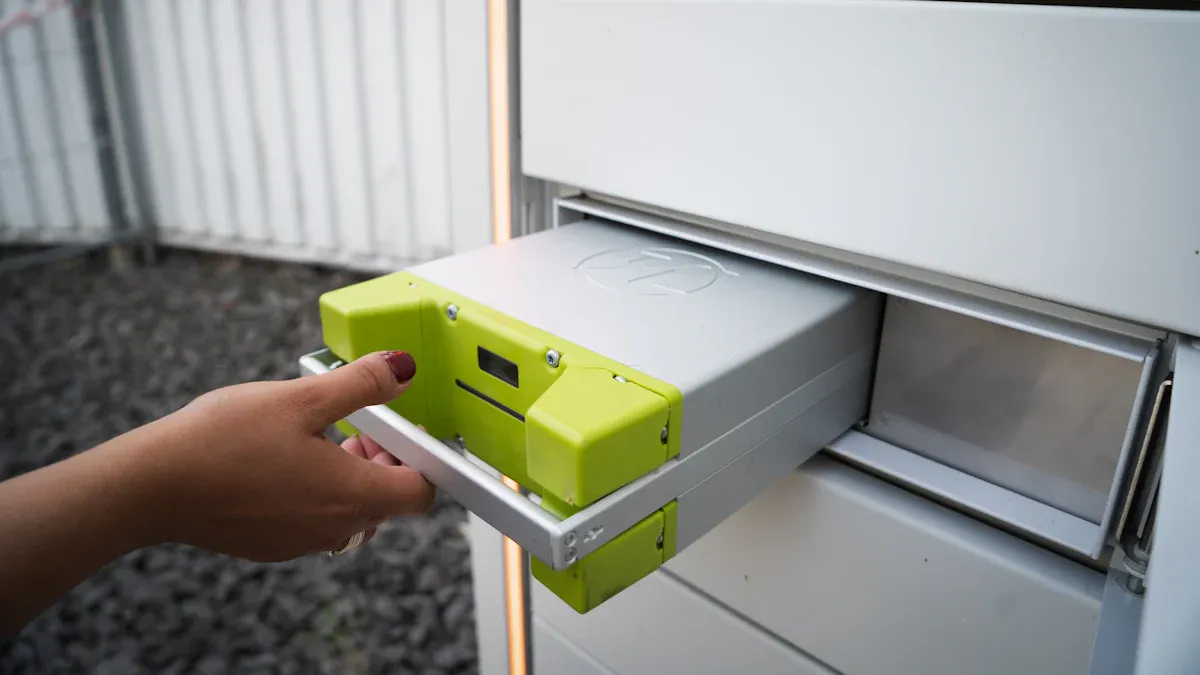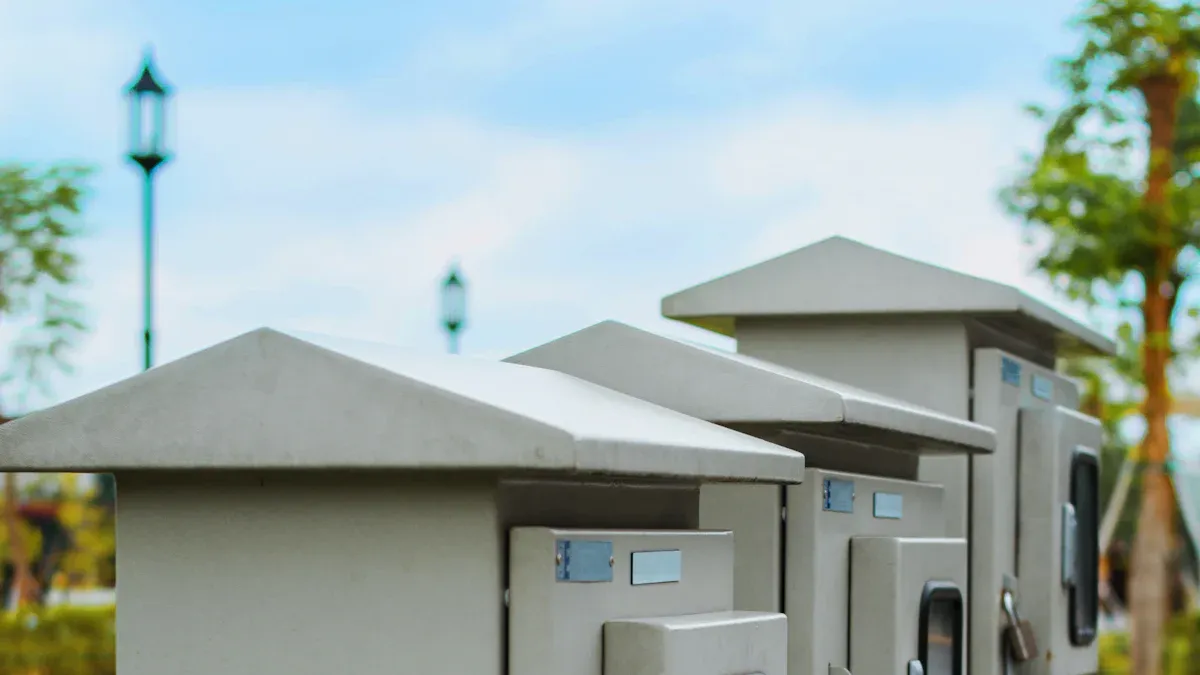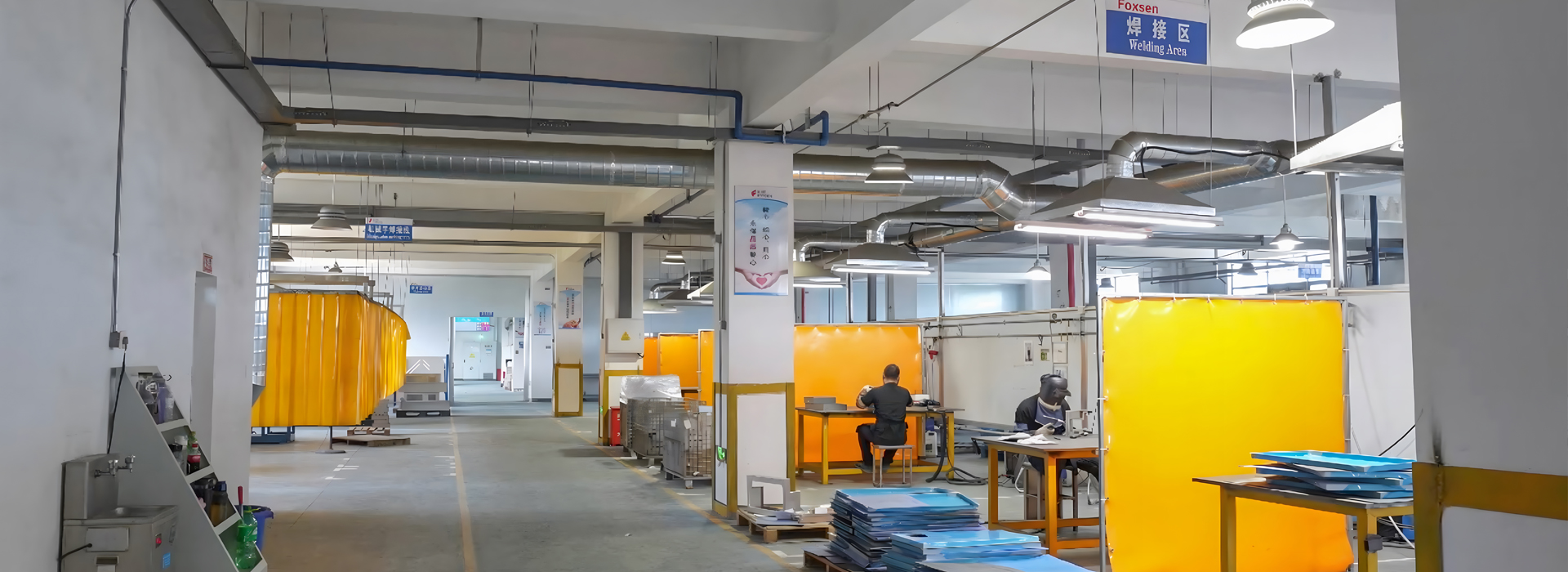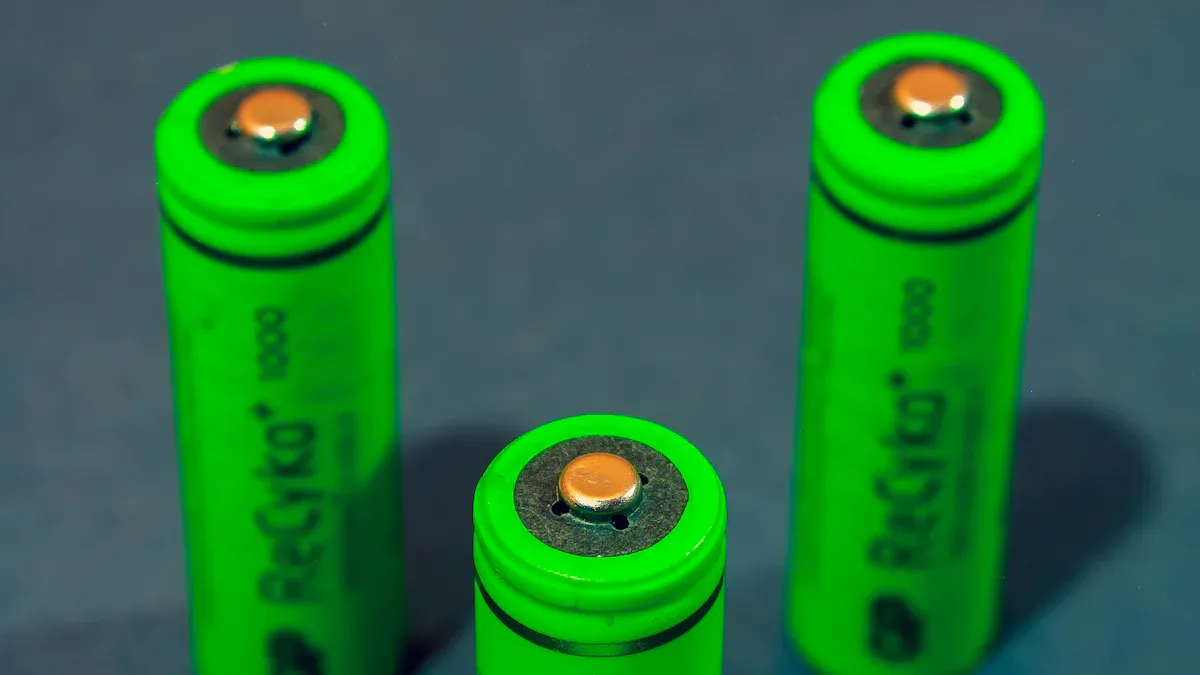When I think about protecting batteries in outdoor spaces, I immediately consider the importance of a durable housing solution. A sheet metal outdoor battery enclosure serves as a sturdy shield, keeping batteries safe from harsh weather, dust, and debris. These enclosures are specifically designed to create a controlled environment, helping batteries perform efficiently. By reducing exposure to external elements, they ensure batteries remain reliable and long-lasting in outdoor conditions.
Key Takeaways
Metal boxes for outdoor batteries keep them safe from bad weather, dirt, and damage. This helps batteries work well.
Picking a box with good airflow and waterproofing is important. It keeps home energy systems safe and working better.
Strong materials like steel and aluminum make these boxes last longer. They are a smart choice for saving money over time.
Newer boxes have cool features to check battery health. They help save energy and find problems early.
You can customize these boxes to fit your energy needs. This makes them work best in different places.
Key Uses of Sheet Metal Outdoor Battery Enclosures

When I think about the versatility of sheet metal outdoor battery enclosures, I see their applications spanning across various sectors. These enclosures provide reliable protection and enhance the performance of batteries in diverse environments. Let me walk you through some of their key uses.
Residential Applications
In residential settings, these enclosures play a crucial role in safeguarding home energy storage systems. Many homeowners now rely on battery systems to store energy from solar panels or as backup power during outages. A well-designed sheet metal outdoor battery enclosure ensures these batteries remain safe from weather extremes, dust, and potential tampering.
I’ve noticed that materials like steel and aluminum are commonly used for these enclosures. Steel offers excellent impact resistance, while aluminum provides lightweight durability and corrosion resistance, making it ideal for outdoor use. These features not only improve battery safety but also extend the lifespan of the system.
Tip: If you’re considering a home energy storage system, choose an enclosure with proper ventilation and weatherproofing to maximize safety and efficiency.
Commercial and Industrial Applications
In commercial and industrial environments, the demand for robust battery enclosures is even greater. Businesses often use these enclosures for uninterruptible power supplies (UPS), industrial automation, and emergency lighting systems. I’ve seen how these applications require enclosures that can withstand harsh conditions, including extreme temperatures and heavy impacts.
Here’s a quick look at some industries where these enclosures are indispensable:
The durability and weather resistance of sheet metal make it the material of choice for these demanding applications. It’s fascinating to see how these enclosures contribute to uninterrupted operations in critical sectors.
Renewable Energy Systems
Renewable energy systems, such as solar and wind power, heavily depend on efficient energy storage solutions. I’ve observed that sheet metal outdoor battery enclosures are a cornerstone of these systems. They protect batteries from environmental factors like rain, snow, and UV radiation, ensuring consistent performance.
The global electric enclosure market reflects the growing adoption of these solutions. It was valued at USD 14.02 billion in 2024 and is projected to reach USD 23.65 billion by 2032, growing at a CAGR of 6.75% from 2025 to 2032. This growth highlights the increasing reliance on enclosures for renewable energy storage.
Note: Properly designed enclosures not only protect batteries but also optimize energy efficiency by maintaining stable operating conditions.
Backup Power Solutions
When I think about backup power solutions, I see them as essential for ensuring uninterrupted energy during emergencies. These systems are critical for homes, businesses, and industries that rely on consistent power to maintain operations. A sheet metal outdoor battery enclosure plays a vital role in protecting the batteries that store this backup energy.
I’ve noticed that these enclosures are particularly useful during power outages caused by storms, grid failures, or other unexpected events. They shield batteries from environmental hazards like rain, snow, and extreme temperatures. This protection ensures the batteries remain functional when they’re needed most.
Here are some common applications where backup power solutions are indispensable:
Residential Use: Homeowners often use backup power systems to keep essential appliances running during outages. Refrigerators, medical devices, and lighting systems depend on reliable energy storage.
Healthcare Facilities: Hospitals and clinics require uninterrupted power for life-saving equipment and critical operations.
Data Centers: These facilities rely on backup power to prevent data loss and maintain server functionality during blackouts.
Retail and Hospitality: Businesses like grocery stores and hotels use backup systems to avoid disruptions and maintain customer satisfaction.
Tip: When choosing a backup power system, ensure the enclosure is designed to withstand the specific environmental conditions of your location.
I’ve seen how the durability of sheet metal makes it ideal for these applications. Its strength and weather resistance provide a reliable housing for batteries, even in challenging outdoor environments. Additionally, these enclosures often include features like ventilation systems and secure locking mechanisms, which enhance both performance and safety.
Backup power solutions are not just about convenience; they’re about preparedness. By investing in a high-quality sheet metal outdoor battery enclosure, you can ensure your energy storage system remains protected and ready to perform when emergencies arise.
Benefits of Sheet Metal Outdoor Battery Enclosures

Enhanced Safety and Protection
When I think about safety, I see sheet metal outdoor battery enclosures as a reliable solution for protecting batteries from external hazards. These enclosures act as a shield against physical damage, tampering, and environmental risks. Their sturdy construction prevents accidents like short circuits or electrical failures caused by water ingress or debris.
I’ve noticed that these enclosures often include features like secure locking mechanisms and reinforced hinges. For example, hinges made from 316-grade stainless steel resist rust and ensure long-term functionality. This design keeps batteries safe from unauthorized access and physical impacts.
Tip: Always choose an enclosure with proper sealing and locking systems to maximize safety for your energy storage system.
Durability and Longevity
Durability is one of the standout qualities of sheet metal outdoor battery enclosures. I’ve seen how their robust construction ensures they last for decades, even in challenging environments. These enclosures are built with materials like rust-resistant stainless steel (316L) and feature protective coatings such as polyurethane and zinc.
Here’s a breakdown of their durability features:
These features make sheet metal enclosures a long-term investment for protecting batteries. I’ve seen how their durability reduces maintenance costs and ensures reliable performance over time.
Weather Resistance and Environmental Protection
Weather resistance is critical for outdoor battery enclosures. I’ve observed how these enclosures protect batteries from environmental factors like rain, UV exposure, and overheating. Without proper protection, these elements can cause rust, material degradation, or equipment malfunction.
For environments with heavy rainfall, enclosures rated IP67 or IP68 are ideal. These ratings indicate waterproof designs that can withstand temporary immersion in water. Proper ventilation systems also prevent overheating, ensuring batteries operate efficiently even in high temperatures.
Here are some common environmental risks these enclosures mitigate:
Water ingress, which can lead to short circuits or rust.
UV exposure, which damages materials over time.
Overheating, which causes equipment malfunction if ventilation is inadequate.
I’ve seen how these features make sheet metal outdoor battery enclosures indispensable for protecting batteries in extreme weather conditions. Their ability to withstand environmental challenges ensures consistent performance and extends the lifespan of energy storage systems.
Energy Optimization and Efficiency
When I think about energy optimization, I see how a well-designed sheet metal outdoor battery enclosure can make a significant difference. These enclosures don’t just protect batteries; they actively contribute to improving energy efficiency and reducing waste. Let me explain how.
One of the key benefits I’ve noticed is how these enclosures help maintain stable operating conditions for batteries. By shielding them from extreme temperatures and environmental fluctuations, they ensure batteries perform at their peak. This stability minimizes energy loss, which directly improves the overall efficiency of energy systems. For example, a battery operating within its optimal temperature range consumes less energy to regulate itself, leaving more power available for actual use.
I’ve also observed how smart features in modern enclosures enhance energy optimization. Many enclosures now come equipped with intelligent monitoring systems that track battery performance in real time. These systems identify inefficiencies and alert users to potential issues before they escalate. This proactive approach not only saves energy but also reduces maintenance costs.
Here are some specific ways these enclosures contribute to energy efficiency:
They reduce energy consumption, which lowers operational costs.
They optimize resource utilization, promoting sustainability in manufacturing.
They minimize waste, helping to reduce the environmental footprint of energy systems.
Note: Investing in an enclosure with smart features can significantly improve the energy efficiency of your system while supporting eco-friendly practices.
Another aspect I find fascinating is how these enclosures support renewable energy systems. Batteries in solar or wind power setups often face challenges like overheating or exposure to UV radiation. A high-quality sheet metal outdoor battery enclosure mitigates these risks, ensuring consistent energy storage and delivery. This reliability is crucial for optimizing the energy output of renewable systems.
In my experience, choosing the right enclosure is essential for maximizing energy efficiency. Features like proper ventilation, thermal insulation, and corrosion-resistant coatings play a vital role. These elements work together to create an environment where batteries can operate efficiently, even in harsh outdoor conditions.
Energy optimization isn’t just about saving costs; it’s about creating a sustainable future. By using advanced enclosures, we can ensure that energy systems perform better, last longer, and leave a smaller environmental footprint. I believe this makes them an indispensable part of any modern energy solution.
Why Sheet Metal Is Ideal for Outdoor Battery Enclosures
Strength and Durability of Sheet Metal
When I think about the strength of sheet metal, I see it as the backbone of outdoor battery enclosures. Its structural durability ensures batteries remain protected even in the harshest conditions. Engineers conduct various tests to confirm this durability.
Static Analysis evaluates how the enclosure handles mechanical stresses, ensuring it can withstand heavy loads without deforming.
Dynamic Analysis tests the enclosure's response to changing loads, simulating real-world conditions like wind or vibrations.
Modal Analysis examines vibrational characteristics, ensuring the enclosure doesn’t compromise the reliability of battery packs.
Material Selection focuses on choosing metals like Q235 steel or Al6061 aluminum for their mechanical strength and thermal conductivity.
These tests highlight why sheet metal is ideal for outdoor battery enclosures. Its ability to endure mechanical stress and environmental challenges makes it a reliable choice for protecting batteries.
Corrosion Resistance and Coatings
Corrosion resistance is another reason sheet metal stands out. I’ve seen how protective coatings enhance its ability to withstand chemical exposure and environmental wear. Different coatings offer varying levels of performance:
I’ve read about advanced coatings like gradient graphene-CrC nanocomposites, which improve corrosion and wear resistance. These coatings ensure sheet metal enclosures last longer, even in environments with high humidity or chemical exposure.
Cost-Effectiveness and Sustainability
Cost-effectiveness is another advantage of sheet metal outdoor battery enclosures. I’ve noticed how manufacturers balance affordability with performance by using materials like aluminum and steel. These metals are widely available, making them cost-efficient for large-scale production.
Sustainability is equally important. Sheet metal is recyclable, which reduces waste and supports eco-friendly practices. I’ve seen how this aligns with the growing demand for sustainable energy solutions. By choosing sheet metal enclosures, we not only save costs but also contribute to a greener future.
Integration with Energy Systems and Compliance Standards
Compatibility with Modern Energy Systems
When I think about modern energy systems, I see how they demand seamless integration with their components. A sheet metal outdoor battery enclosure plays a vital role in this process. These enclosures are designed to house batteries that work with solar panels, wind turbines, and other renewable energy sources. They ensure batteries operate efficiently by maintaining stable conditions, even in fluctuating outdoor environments.
I’ve noticed that many enclosures now include features like smart monitoring systems. These systems track battery performance and send real-time data to energy management platforms. This compatibility allows users to optimize energy usage and identify potential issues early. For example, a homeowner with a solar energy system can monitor battery health and adjust energy consumption based on weather conditions.
Tip: Look for enclosures with built-in monitoring capabilities to enhance the efficiency of your energy system.
Compliance with Safety and Industry Regulations
Safety and compliance are non-negotiable when it comes to energy storage. I’ve seen how manufacturers design enclosures to meet strict industry standards, such as UL 9540 for energy storage systems and IP ratings for environmental protection. These certifications ensure the enclosures provide reliable safety features, like fire resistance and waterproofing.
For instance, an IP67-rated enclosure offers excellent protection against dust and temporary water immersion. This level of compliance is crucial for industries like telecommunications and healthcare, where uninterrupted power is essential. By adhering to these standards, enclosures not only protect batteries but also safeguard the systems they support.
Note: Always verify that your enclosure meets the necessary safety and regulatory requirements for your specific application.
Customization for Specific Energy Needs
Every energy system has unique requirements. I’ve observed how customizable enclosures address these needs effectively. Manufacturers offer options like adjustable sizes, specialized coatings, and additional ventilation systems. These features allow enclosures to adapt to different environments and energy demands.
For example, a business operating in a coastal area might need an enclosure with enhanced corrosion resistance. On the other hand, a residential user in a cold climate might prioritize thermal insulation. Customization ensures the enclosure aligns perfectly with the system’s operational goals.
Callout: Customization not only improves performance but also extends the lifespan of your energy storage system.
When I think about the value of a sheet metal outdoor battery enclosure, I see it as a cornerstone for protecting batteries and optimizing energy systems. Its crashworthiness, enhanced by materials like steel and aluminum, ensures safety and durability across sectors, from residential to automotive. Foxsen’s expertise in crafting high-quality enclosures stands out. Their designs combine structural integrity with advanced coatings, delivering reliable performance in harsh environments. By choosing Foxsen, I believe users can safeguard their energy systems while maximizing efficiency and longevity.
FAQ
What makes sheet metal better than plastic for outdoor battery enclosures?
I’ve found that sheet metal offers superior strength and durability compared to plastic. It resists impacts, extreme temperatures, and environmental wear. Plastic enclosures may crack or degrade over time, but sheet metal remains reliable, especially in harsh outdoor conditions.
How do I choose the right enclosure size for my battery system?
I always recommend measuring your battery dimensions first. Add extra space for ventilation and wiring. Manufacturers often provide size guides, which help match enclosures to specific battery models. Proper sizing ensures optimal performance and safety.
Are sheet metal enclosures suitable for coastal areas?
Yes, they are. I’ve seen enclosures with corrosion-resistant coatings, like zinc or polyurethane, perform well in coastal environments. These coatings protect against saltwater and humidity, ensuring long-lasting durability. Always choose enclosures designed for high-corrosion areas.
Can I customize a sheet metal enclosure for my energy system?
Absolutely! Many manufacturers offer customization options. I’ve noticed features like adjustable sizes, specialized coatings, and additional ventilation systems. These options allow enclosures to meet specific energy needs, whether for residential, commercial, or industrial applications.
Do sheet metal enclosures require regular maintenance?
Not much. I’ve observed that high-quality enclosures with protective coatings need minimal upkeep. Occasionally check for dirt, debris, or damage. Cleaning with a damp cloth and inspecting hinges or locks ensures the enclosure stays in top condition.






